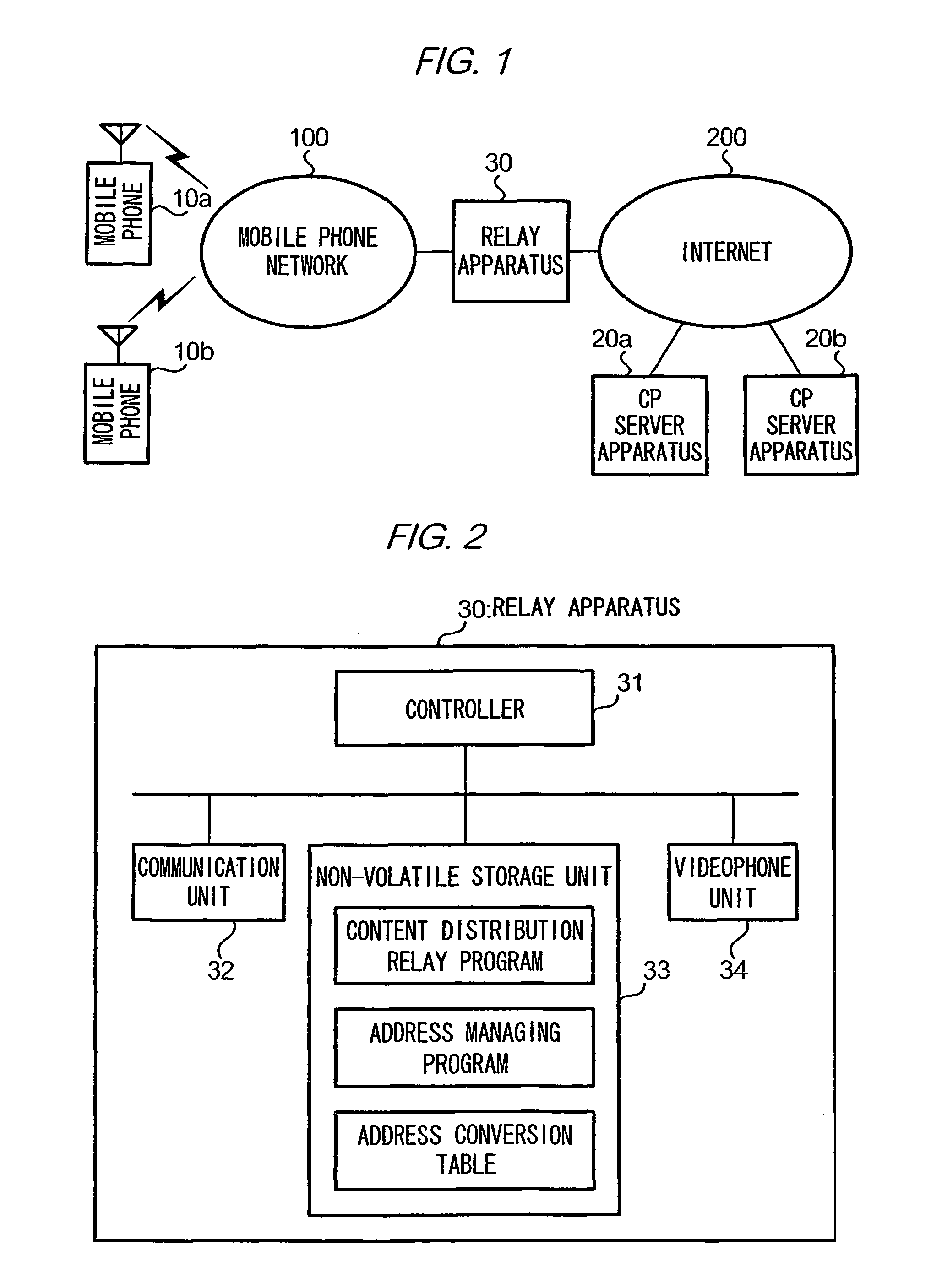Content distribution method and relay apparatus
a technology of relay apparatus and relay device, which is applied in the direction of transmission monitoring, television system, instruments, etc., can solve the problems of user operation burden and complicated configuration of sub-address, so as to avoid increasing the number of digits of sub-address or complicating configuration
- Summary
- Abstract
- Description
- Claims
- Application Information
AI Technical Summary
Benefits of technology
Problems solved by technology
Method used
Image
Examples
first embodiment
(1) First Embodiment
(1-1) Configuration
[0034]FIG. 1 is a block diagram showing the overall configuration of a content distribution system according to the first embodiment. In FIG. 1, a mobile phone network 100 is constituted by communications equipment of the IMT-2000 (International Mobile Telecommunications-2000) standard, for example. The IMT-2000 standard is able to realize high-speed data communication of about several hundred kbps to several Mbps. Since such high-speed data communication is possible, the mobile phones 10a and 10b served in the mobile phone network 100 can realize a videophone function by use of the videophone protocol. Moreover, the mobile phones 10a and 10b store a WWW browser program, and through execution of the same, they can interpret screen data in HTML (Hypertext Markup Language) format obtained from the WWW (World Wide Web) and display various kinds of dialogue screens on a display.
[0035]CP (Content Provider) server apparatuses 20a and 20b are connecte...
second embodiment
(2) Second Embodiment
[0058]The second embodiment explained in the following differs from the first embodiment in that the Steps S6a to S11a shown in FIG. 10 are performed instead of the Steps S6 to S11 shown in FIG. 5.
[0059]Referring to FIG. 10, the following is an explanation of the operation of the second embodiment.
[0060]The mobile phone 10a displays the menu screen data shown in FIG. 6 on its display. When the user of the mobile phone 10a performs an operation to select the character string “Action A” shown in FIG. 6, the mobile phone 10a accepts this operation as a content request operation (Step S5) and sends out an HTTP request including the associated URL as a sub-address issue request (Step S6a). This URL is a URL assigned to the relay device 30, and contains the URL “http: / / www.xxx.co.jp / actionA.mp4” indicating the storage location of the content as a CGI parameter.
[0061]When the communication unit 32 of the relay apparatus 30 receives this HTTP request, the controller 31 ...
modification examples
(3) Modification Examples
[0064]The present invention is not limited to the above-described embodiments, and for example the following modifications are possible.
PUM
 Login to View More
Login to View More Abstract
Description
Claims
Application Information
 Login to View More
Login to View More - R&D
- Intellectual Property
- Life Sciences
- Materials
- Tech Scout
- Unparalleled Data Quality
- Higher Quality Content
- 60% Fewer Hallucinations
Browse by: Latest US Patents, China's latest patents, Technical Efficacy Thesaurus, Application Domain, Technology Topic, Popular Technical Reports.
© 2025 PatSnap. All rights reserved.Legal|Privacy policy|Modern Slavery Act Transparency Statement|Sitemap|About US| Contact US: help@patsnap.com



